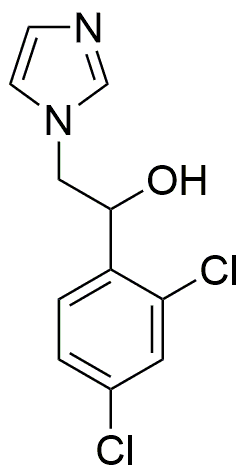1-(2,4-Dichlorophenyl)-2-(1-imidazolyl)ethanol is widely utilized in research focused on:
- Pharmaceutical Development: This compound is often explored for its potential as an antifungal agent, making it valuable in the development of new medications for treating fungal infections.
- Agricultural Chemistry: Its properties can be harnessed in formulating pesticides, providing effective solutions for crop protection against fungal pathogens.
- Biochemical Research: Researchers use this compound to study its interactions with biological systems, particularly in understanding enzyme inhibition and metabolic pathways.
- Material Science: It can be incorporated into polymers to enhance their antimicrobial properties, leading to safer materials for medical devices and packaging.
- Environmental Science: The compound is examined for its role in bioremediation processes, helping to break down pollutants in contaminated environments.
General Information
Properties
Safety and Regulations
Applications
1-(2,4-Dichlorophenyl)-2-(1-imidazolyl)ethanol is widely utilized in research focused on:
- Pharmaceutical Development: This compound is often explored for its potential as an antifungal agent, making it valuable in the development of new medications for treating fungal infections.
- Agricultural Chemistry: Its properties can be harnessed in formulating pesticides, providing effective solutions for crop protection against fungal pathogens.
- Biochemical Research: Researchers use this compound to study its interactions with biological systems, particularly in understanding enzyme inhibition and metabolic pathways.
- Material Science: It can be incorporated into polymers to enhance their antimicrobial properties, leading to safer materials for medical devices and packaging.
- Environmental Science: The compound is examined for its role in bioremediation processes, helping to break down pollutants in contaminated environments.
Documents
Safety Data Sheets (SDS)
The SDS provides comprehensive safety information on handling, storage, and disposal of the product.
Product Specification (PS)
The PS provides a comprehensive breakdown of the product’s properties, including chemical composition, physical state, purity, and storage requirements. It also details acceptable quality ranges and the product's intended applications.
Certificates of Analysis (COA)
Search for Certificates of Analysis (COA) by entering the products Lot Number. Lot and Batch Numbers can be found on a product’s label following the words ‘Lot’ or ‘Batch’.
*Catalog Number
*Lot Number
Certificates Of Origin (COO)
This COO confirms the country where the product was manufactured, and also details the materials and components used in it and whether it is derived from natural, synthetic, or other specific sources. This certificate may be required for customs, trade, and regulatory compliance.
*Catalog Number
*Lot Number
Safety Data Sheets (SDS)
The SDS provides comprehensive safety information on handling, storage, and disposal of the product.
DownloadProduct Specification (PS)
The PS provides a comprehensive breakdown of the product’s properties, including chemical composition, physical state, purity, and storage requirements. It also details acceptable quality ranges and the product's intended applications.
DownloadCertificates of Analysis (COA)
Search for Certificates of Analysis (COA) by entering the products Lot Number. Lot and Batch Numbers can be found on a product’s label following the words ‘Lot’ or ‘Batch’.
*Catalog Number
*Lot Number
Certificates Of Origin (COO)
This COO confirms the country where the product was manufactured, and also details the materials and components used in it and whether it is derived from natural, synthetic, or other specific sources. This certificate may be required for customs, trade, and regulatory compliance.


